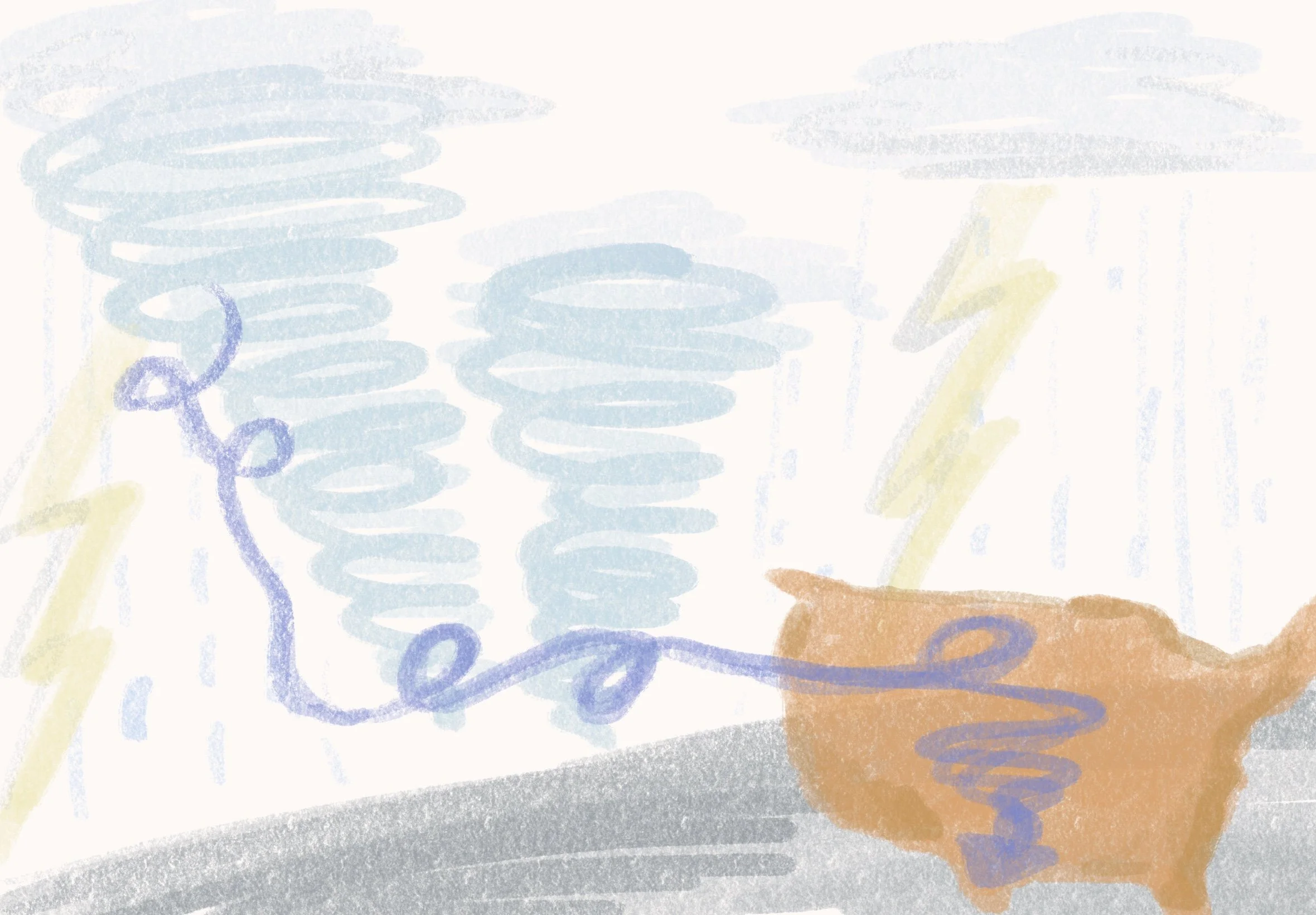Not in Kansas Anymore: The Devastation of Midwest Tornadoes
Maia Wijnberg ’26
Cathy Zhang ’26
The movie Twisters, starring Daisy Edgar-Jones, Glen Powell, and many other popular actors, took summer 2024 by storm following its release on July 19th. A sequel to the 1996 film Twister, this film details the story of rival storm chasers as they hunt down dangerous tornadoes in Oklahoma. While some of the movie’s details are dramatized, the plot remains close to the real science. This region, nicknamed “Tornado Alley,” includes parts of Oklahoma, Texas, Kansas, and Nebraska, and experiences frequent tornadoes throughout the year, although peaking April-June. The film bases its conflict around a severe increase in tornado frequency, which parallels current data. According to preliminary data from the National Oceanic and Atmospheric Administration (NOAA), 2024 tornado reports were double the average from 1991-2022 in May and July (Bamberg, 2024). The number of tornadoes in 2024 also exceeded the average from the last five years. However, several other studies published different claims about recent tornado seasons. Research from NPJ Climate and Atmospheric Sciences argues that Tornado Alley is experiencing a decrease in tornadoes and that the Midwest and Southeastern U.S. are experiencing an increase instead (Gensini & Brooks, 2018). But why is this shift occurring and what does that mean for these regions?
Tornadoes occur when surface temperatures are much warmer than higher up in the atmosphere and strong wind shear is present, often during thunderstorms. While individual tornadoes cannot result from climate change, global warming leads to more and more days with conditions perfect for this weather event (The Ohio State University, 2023). However, the shifting of Tornado Alley and its motives is still unclear, as tornadoes historically peak in different areas during different seasons. Additionally, there are potential discrepancies in tornado reports, with some measurements not matching the recorded shift. Today, tornadoes become increasingly unpredictable in scale, frequency, and location, targeting new areas as a potential side-effect of climate change.
Tornadoes cause terrible damage, especially when they hit underprepared communities in these new regions. This harm is evident in the measurement system. Tornadoes are classified according to the damage they cause, resulting from their wind speed on a 0-5 scale (NOAA National Severe Storms Laboratory, 2021). Annually, the storms cause 80 deaths and over 1,500 injuries. Furthermore, they cause around $400 million in damage to homes, businesses, and even transportation (National Geographic Staff, 2019). They also can impair communities by destroying important infrastructure, causing power outages, water contamination, loss of communication, and many other vital services (Federal Emergency Management Agency, 2025). Thunderstorms often accompany tornadoes, adding flash flooding, hail, and other dangers to the worries of already struggling districts. For example, Hurricanes Helene and Milton spawned 66 tornadoes this past fall, furthering the pain in these areas and spreading debris across regions outside the hurricanes’ direct reach. The damage of these tornadoes is that they often occur in rural areas that are short on resources, which makes reconstruction much slower and more difficult. The weather events frequently destroy difficult-to-replace housing, like mobile or uninsured homes, creating an even bigger humanitarian issue (Center for Disaster Philanthropy, 2024).
However, there are several ways in which people can aid those impacted by tornadoes. FEMA, the Red Cross, and the Center for Disaster Philanthropy are all examples of organizations dedicated to providing relief for crises, including tornado relief. They provide housing, food, safe water, mental health support, and money to victims (American Red Cross, 2023). Beyond donations or volunteer work, reducing one’s carbon footprint would also help to limit the rising unpredictability of these weather events, mitigating the dangers. Although tornadoes and other extreme weather events will always continue to exist, people still can protect victims.
References:
American Red Cross. (2023). Tornado Relief. Redcross.org. https://www.redcross.org/about-us/our-work/disaster-relief/tornado-relief.html#:~:text=Tornadoes%20strike%20quickly%2C%20leaving%20communities,Shelter%20and%20feed%20residents
Bamberg, J. (2024, August 20). GRAPHIC: Tornados are increasing in frequency across the US. Investigate Midwest. https://investigatemidwest.org/2024/08/20/graphic-tornados-are-increasing-in-frequency-across-the-us/
Center for Disaster Philanthropy. (2024, October 31). 2024 US Tornadoes - Center for Disaster Philanthropy. Disasterphilanthropy.org. https://disasterphilanthropy.org/disasters/2024-us-tornadoes/?gad_source=1&gclid=CjwKCAiAh6y9BhBREiwApBLHCyDLeVd4tIkFtDFv-nscqrdi6G_qcQQ4GV4ryvMKHVUfZ_i_21XUWBoCirYQAvD_BwE
Federal Emergency Management Agency. (2025). Tornado | Impact. Community.fema.gov. https://community.fema.gov/ProtectiveActions/s/article/Tornado-Impact
Gensini, V. A., & Brooks, H. E. (2018). Spatial trends in United States tornado frequency. Npj Climate and Atmospheric Science, 1(1). https://doi.org/10.1038/s41612-018-0048-2
National Geographic Staff. (2019, August 28). Tornadoes, explained. Environment; National Geographic. https://www.nationalgeographic.com/environment/article/tornadoes
NOAA National Severe Storms Laboratory. (2021). Severe Weather 101 - Tornado Basics. NSSL | NOAA National Severe Storms Laboratory. https://www.nssl.noaa.gov/education/svrwx101/tornadoes/
The Ohio State University. (2023, May 19). Is “Tornado Alley” Moving East, Covering Parts of Central Ohio? Climate.osu.edu. https://climate.osu.edu/news/tornado-alley-moving-east-covering-parts-central-ohio
